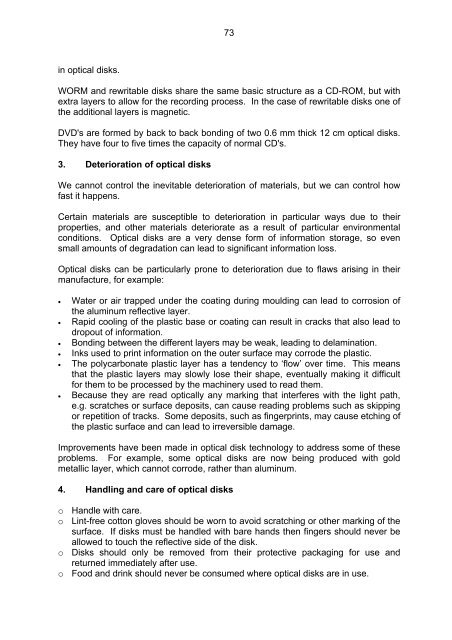managing electronic records in governmental bodies - National ...
managing electronic records in governmental bodies - National ...
managing electronic records in governmental bodies - National ...
Create successful ePaper yourself
Turn your PDF publications into a flip-book with our unique Google optimized e-Paper software.
73<br />
<strong>in</strong> optical disks.<br />
WORM and rewritable disks share the same basic structure as a CD-ROM, but with<br />
extra layers to allow for the record<strong>in</strong>g process. In the case of rewritable disks one of<br />
the additional layers is magnetic.<br />
DVD's are formed by back to back bond<strong>in</strong>g of two 0.6 mm thick 12 cm optical disks.<br />
They have four to five times the capacity of normal CD's.<br />
3. Deterioration of optical disks<br />
We cannot control the <strong>in</strong>evitable deterioration of materials, but we can control how<br />
fast it happens.<br />
Certa<strong>in</strong> materials are susceptible to deterioration <strong>in</strong> particular ways due to their<br />
properties, and other materials deteriorate as a result of particular environmental<br />
conditions. Optical disks are a very dense form of <strong>in</strong>formation storage, so even<br />
small amounts of degradation can lead to significant <strong>in</strong>formation loss.<br />
Optical disks can be particularly prone to deterioration due to flaws aris<strong>in</strong>g <strong>in</strong> their<br />
manufacture, for example:<br />
• Water or air trapped under the coat<strong>in</strong>g dur<strong>in</strong>g mould<strong>in</strong>g can lead to corrosion of<br />
the alum<strong>in</strong>um reflective layer.<br />
• Rapid cool<strong>in</strong>g of the plastic base or coat<strong>in</strong>g can result <strong>in</strong> cracks that also lead to<br />
dropout of <strong>in</strong>formation.<br />
• Bond<strong>in</strong>g between the different layers may be weak, lead<strong>in</strong>g to delam<strong>in</strong>ation.<br />
• Inks used to pr<strong>in</strong>t <strong>in</strong>formation on the outer surface may corrode the plastic.<br />
• The polycarbonate plastic layer has a tendency to ‘flow’ over time. This means<br />
that the plastic layers may slowly lose their shape, eventually mak<strong>in</strong>g it difficult<br />
for them to be processed by the mach<strong>in</strong>ery used to read them.<br />
• Because they are read optically any mark<strong>in</strong>g that <strong>in</strong>terferes with the light path,<br />
e.g. scratches or surface deposits, can cause read<strong>in</strong>g problems such as skipp<strong>in</strong>g<br />
or repetition of tracks. Some deposits, such as f<strong>in</strong>gerpr<strong>in</strong>ts, may cause etch<strong>in</strong>g of<br />
the plastic surface and can lead to irreversible damage.<br />
Improvements have been made <strong>in</strong> optical disk technology to address some of these<br />
problems. For example, some optical disks are now be<strong>in</strong>g produced with gold<br />
metallic layer, which cannot corrode, rather than alum<strong>in</strong>um.<br />
4. Handl<strong>in</strong>g and care of optical disks<br />
o Handle with care.<br />
o L<strong>in</strong>t-free cotton gloves should be worn to avoid scratch<strong>in</strong>g or other mark<strong>in</strong>g of the<br />
surface. If disks must be handled with bare hands then f<strong>in</strong>gers should never be<br />
allowed to touch the reflective side of the disk.<br />
o Disks should only be removed from their protective packag<strong>in</strong>g for use and<br />
returned immediately after use.<br />
o Food and dr<strong>in</strong>k should never be consumed where optical disks are <strong>in</strong> use.
















